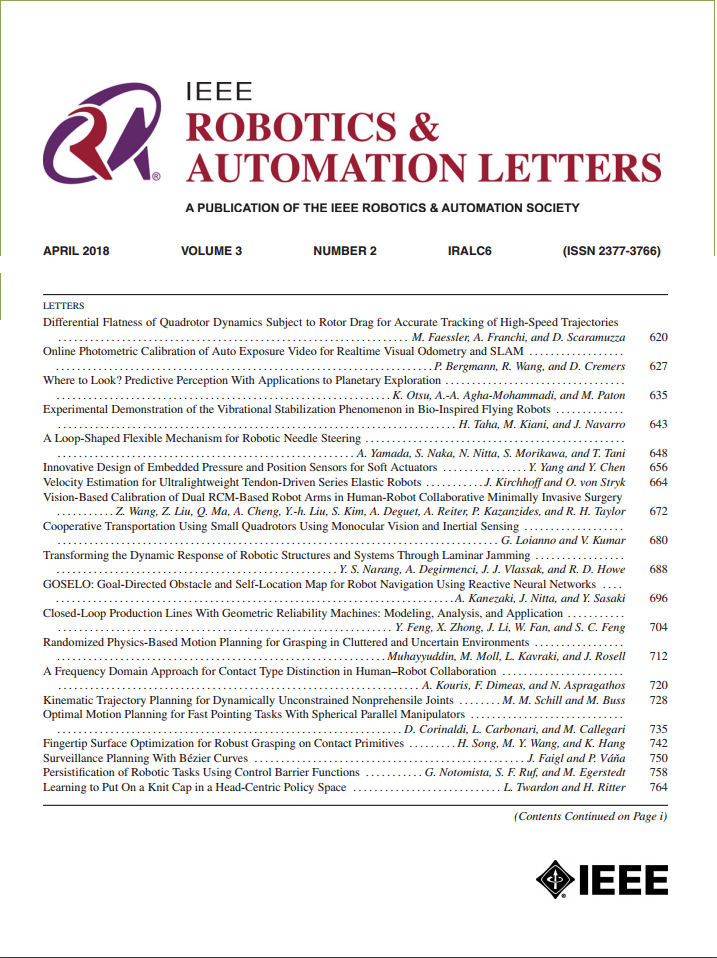基于路网约束隐马尔可夫模型的脑启发视觉拓扑定位
IF 5.3
2区 计算机科学
Q2 ROBOTICS
引用次数: 0
摘要
在无gps环境下的精确定位仍然是自主机器人导航面临的关键挑战。动物依靠心理认知地图,在复杂、动态的环境中表现出非凡的导航能力。受头部方向细胞和网格细胞等神经表征的启发,许多机器人认知地图系统可以有效地覆盖大面积;然而,它们通常缺乏精确定位所需的精确度量信息。为了解决这一挑战,我们提出了一种基于道路网络约束的神经动力学驱动的单目视觉地形定位方法。我们引入路网约束隐马尔可夫模型(RC-HMM),通过纳入路网约束来增强半度量地图,形成一个保持顶点关系并提高定位精度的连贯地形地图。在CARLA Town07环境中的实验结果证明了地形测量认知图的显著效率。与半度量地图相比,我们的方法在绝对姿势误差(APE)上减少了95%,在相对姿势误差(RPE)上减少了81%。与双筒ORB-SLAM3相比,我们的单筒ORB-SLAM3方法降低了96.7%的CPU使用率和77.7%的地图存储,APE为3.6 m, RPE为1.4 m,与ORB-SLAM3的3.86 m APE和0.96 m RPE非常接近。此外,通过利用网格细胞和头部方向细胞的神经动力学,我们的单眼地形定位可以提供3.86米的定位精度,与双目ORB-SLAM3相当。这种方法将道路网络指标集成到拓扑图中,在复杂环境中通过地形地图增强大脑导航。本文章由计算机程序翻译,如有差异,请以英文原文为准。
Brain-Inspired Visual Topometric Localization via Roadnetwork-Constraint Hidden Markov Model
Accurate localization in GPS-denied environments remains a critical challenge for autonomous robot navigation. Animals exhibit remarkable navigational abilities in complex, dynamic environments by relying on mental cognitive maps. Inspired by neural representations such as head direction cells and grid cells, numerous robotic cognitive mapping systems can efficiently cover large areas; however, they often lack the precise metric information required for accurate localization. To address this challenge, we propose a neurodynamically driven monocular visual topometric localization approach based on road network constraints. We introduce the Roadnetwork-Constraint Hidden Markov Model (RC-HMM) to enhance the semi-metric map by incorporating road network constraints, forming a coherent topometric map that maintains vertex relationships and improves localization accuracy. Experimental results in the CARLA Town07 environment demonstrate the remarkable efficiency of our topometric cognitive map. Compared to the semi-metric map, our approach achieves a 95% reduction in Absolute Pose Error (APE) and an 81% reduction in Relative Pose Error (RPE). Compared to binocular ORB-SLAM3, our monocular approach reduces CPU usage by 96.7% and map storage by 77.7%, with an APE of 3.6 m and RPE of 1.4 m — closely matching ORB-SLAM3’s 3.86 m APE and 0.96 m RPE. Furthermore, by leveraging neurodynamics of grid cells and head direction cells, our monocular topometric localization robustly delivers the localization accuracy of 3.86 meters, comparable to binocular ORB-SLAM3. This approach integrates road network metrics into topological maps, enhancing brain-inspired navigation with topometric maps in complex environments.
求助全文
通过发布文献求助,成功后即可免费获取论文全文。
去求助
来源期刊

IEEE Robotics and Automation Letters
Computer Science-Computer Science Applications
CiteScore
9.60
自引率
15.40%
发文量
1428
期刊介绍:
The scope of this journal is to publish peer-reviewed articles that provide a timely and concise account of innovative research ideas and application results, reporting significant theoretical findings and application case studies in areas of robotics and automation.
 求助内容:
求助内容: 应助结果提醒方式:
应助结果提醒方式:


